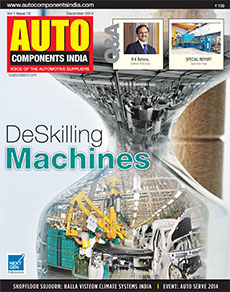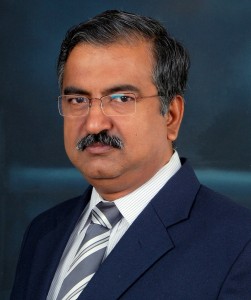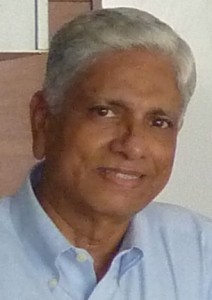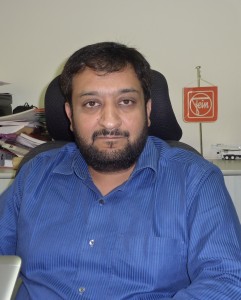By T Murrali
For more than a century machines have begun making their presence felt in manufacturing as production germinated from single pieces to batches, and finally mass manufacture. Today, in auto components manufacturing, even the smallest of things – loading and unloading of non-heavy and non-hazardous components – are done by machines. In this scenario, what is in store for people? Are automation and machines required to this level?
 When mass production became the norm, mechanisation embarked on adorning several machines for the manufacturing companies. This only increased with demand from end-customers becoming stronger to not only get quality products but also acquire them when needed. It changed the landscape of manufacturing in almost all the Tier-1 companies and, to some extent, the Tier-2s in the value chain.
When mass production became the norm, mechanisation embarked on adorning several machines for the manufacturing companies. This only increased with demand from end-customers becoming stronger to not only get quality products but also acquire them when needed. It changed the landscape of manufacturing in almost all the Tier-1 companies and, to some extent, the Tier-2s in the value chain.
The now nearly extinct Ambassador car, for instance, was assembled by manufacturing almost all the parts in-house, except the tyre, windscreen and paint. And the manufacturing was done largely by the workforce. Since globalisation, most OEMs in India began to procure almost everything as sub-assemblies, systems and modules and assembled them at their respective factories. This transformation also contributed to further invasions by machines in manufacturing operations. It did not confine itself to only the manufacturing part of the auto industry; gradually the trend engulfed the vehicle service segment in the aftermarket, which comprises of vehicle dealers, parts distributors and mechanics.
Aftermarket
Every job in the vehicle manufacturing sector generates 4 potential jobs in the aftermarket, for servicing vehicles. The size of the aftermarket is estimated at about Rs 48,000 crore, with the spareparts business accounting for about Rs 38,000 crore and the rest by the services. The Rs 10,000 crore service business can only increase with the ever growing vehicle population. Moreover, the composition of vehicles being produced in India is fast changing with the number of vehicles with higher technology expected to reach 41% of the total market size compared to the present 31%. The gain will directly impact the service market. Leveraging opportunities, several non-vehicle manufacturing companies are getting into the automotive space, besides increasing activity in branded service networks.
R Dinesh, Joint Managing Director, T V Sundram Iyengar & Sons Ltd, during a recent interaction, said, the automotive aftermarket is of utmost importance since it is the largest employer of semi-skilled labour in the country. Giving industry status for this segment will help manage a few concerns including the funds crunch that prevents technology upgradation. The demand for labour is about 25 lakh people in a state like Tamil Nadu and the figures will be humongous considering the demand from across the country. However, this segment has a different reason for embracing machines and automation since modern vehicles are manufactured with several sub-assemblies that are calibrated through computers. For regular maintenance, prognostics are warranted that can be done by specialised equipment. In the case of servicing or repairing too, vehicles need a host of diagnostic tools for servicing and, therefore, the service centres are opting for more machines. Besides this, customer expectations are also driving the intent. For instance, customers of high-end cars do not mind paying some premium for getting high-tech service.
Speaking on behalf of vehicle servicing segment, Mananathan Kalaiichelvan, Managing Director, Manatec Electronics sees modernisation of workshops as long overdue in India, for it is dominated by roadside repair shops. Modern service equipment took over traditional servicing methods simply because, OBD, for instance, is a must in dealing with electronics in cars today. Computerised wheel alignment equipment is compulsory as the traditional measurement and correction system does not help in workshop productivity anymore. Similarly, modern crash repair systems are helping in productivity compared to traditional dent-pull systems.
Labour issue
Though not many people are ready to voice their concerns on this issue since it is sensitive, several OEMs and suppliers have stated that labour unrest has precisely been the reason for their foray into increasing mechanisation. The list of battered organisations is on the rise, of late, with several OEMs including the market leader Maruti and the largest exporter of cars – Hyundai Motor India, and many Tier-1 companies including Bosch, Pricol, MRF Tyres etc affected much by it.
Machines Invading Shopfloor
Barring labour unrest there are few reasons for machines to invade the shopfloor. According to the CEO of Micromatic Machine Tools, Ramesh TK, high-volume products that require sorting, correcting, packaging etc and warranting standardisation, need machines. In the case of metal working segment, the changing requirements demand quality certification that can come from accurate measurements etc, which are beyond the realm of human possibility. “The complexity of shapes from functional point of view, aesthetics, design, the degrees of finesse required, needs mechanised means. Therefore, mechanisation has to happen and will only increase over a period of time. In India, because of the large population we keep looking at the moral side of automation but from the practical point of view, the pursuit of man has to be on how to get better, how to plan, get control etc., which a machine will find difficult to do” he said.
Voicing his opinion, S Ravishankar, Deputy Managing Director, Yamazaki Mazak India, said the changing scenario in automobiles – from slow speed guzzlers to faster and fuel efficient vehicles, call for high accuracy components that can be manufactured only by high-tech machines. The development in cutting material which makes cutting faster, improvement in the microprocessors, enforcing the 3D model into the system and the ability to do virtual simulation, have all contributed to the change.
From the user point of view, S Seetharaman, Managing Director, Super Auto Forge said every tool now is a throw-away insert and so the skill of the operator is limited to just clamp it and use. Earlier, the centre height setting itself was a skill. So manufacturers have gone in a big way to make machines where too much skill is not required. Even presses are operated by women, which were earlier a men’s bastion, because of lesser skill requirement.
When asked who is to be blamed for this, Seetharaman said, “Partly we the user industry; maybe we should have kept skill learning on parity with development. Nobody wants to learn more as they get minimum wages. Earlier, if a worker learnt an additional skill he would earn little more.” He further said that more than 50 years ago there were fitters who could repair even imported machines; those skills have completely vanished now. The institutions like ITIs are partly responsible for this.
From the tools manufacturer perspective, Ameer Ahamed Munaff, CEO, FEIN Power Tools India, said the objective for mechanisation was to reduce overall cost of the process or product, reduce time and effort, increase quality and enhance productivity, which are also the core principles of his company. All these come at a cost; however, it will help accomplish the objectives. A S Ponnuswamy, Correspondent, T S Srinivasan Centre for Polytechnic College and Advanced Training, said machines were introduced to take up the drudgery of repetitive work. So, by using machines, performance has increased and, therefore, manpower is used only for supervising. “We are currently training the workers in certain specialised courses, which are required by the industry,” he said.
In the vehicle service segment people availability is not a problem but the skill gap and training are the issues, Kalaiichelvan says. In the absence of many professional training centres, there is always a huge demand for skilled technicians; as a result, the reliance on machines is increasing for servicing needs. Also, the role of technicians cannot be ruled out. “We still need technicians to operate the machines efficiently,” reiterates Kalaiichelvan.
Next Move
Machines have come thus far, making life simpler; so what can the future course of development be in this space? Ramesh foresees that there will be some kind of evolution of the machine itself to optimise operations and make them faster. Today, machines are capable of doing certain kinds of repeat operations. Perhaps, the future will look at machines that can combine multiple units for combined operations. Instead of multiple stations, the station numbers could get reduced. Furthermore, he sees that there could be some kind of connectivity between material and machines with information technology playing a key role.
Seetharaman, who is also into building special purpose machines, says the machine builders themselves need very skilled people. Likewise, there are many allied industries like medical equipment, paper & pulp and textiles where skilled people are always needed; those industries require little more skilled people than what is required in auto components manufacturing because of repetitive production. Collectively, government plus industry have to spend money to get better people, he said.
According to Ravishankar, the next level in deskilling people will be in the area of process where it is all pre-defined; once a particular feature on the 3D model is selected, it can automatically take up the process. Machines will become smarter and Mazak has already pioneered in intelligent voice advisor – alerting the operator by voice-prompt on the operations. It is a form of idiot-proofing concept as the machines tell the operator what he has chosen to do, due to the presence of several sensors.
Machine builders promote more mechanisation because they get the benefit from it, states Seetharaman. “The basic reason is because the end-users need it. The manufacturers need that kind of equipment that can even be operated by totally unskilled. New people are employed regularly and we cannot waste 3 or 4 months in training them. So if we have machines that can be operated by the unskilled or moderately skilled then we can make sure that there is no downtime for machines for want of men. Also, such machines make it less tedious for the operator as the ergonomics are considered, with the result productivity increases. So, eventually, these things benefit the industry in terms of quality and consistency, eliminating rejections and waste, etc,” he opined.
Ravishankar says that as of today the machine is prompting the operator to undertake certain preventive maintenance based on the number of hours of usage. Once the machine is equipped with a SIM card or connected to the network, it will send out a message or email to the maintenance department on the service requirements. These are a little beyond the existing remote diagnostics.
“Maintenance and repair are going to be the keys in education, so we need to upgrade ourselves in mechatronics depending upon the market conditions and modern trends. We are looking at options on how to develop the skills in modernised equipment, operated by the students. Like in other countries, the manufacturing industry also needs to support us. The training institutions and Universities need to offer special courses rather than provide generic ones. The students also have to undergo a lot of practical training so that whatever they study in theory can be better understood in practical workshops,” opines Ponnuswamy.
Way Forward for Workforce
Ramesh believes that the workforce needs to be re-skilled; instead of they doing the work, they will get the machines to do it. Also, there are going to be issues with the machines themselves, like disposal of waste from the process, and the correctness, accuracy and speed that cannot be mechanised. “The mechanisation process will have to happen by people looking at bottlenecks, correcting them and optimising the automation; and further reducing unwanted movements or operations – this is something that no machine can do,” he opined.
Seetharaman laments that, “even with so much of population and unemployment I don’t get people for my factory or household. Where are they? The only way we can achieve more is by using multi machines.” Ravishankar asks how many people prefer to take up routine work in the shopfloor as it is more of a mechanical work with less of intelligence being used. “We have to also consider peoples’ fatigue, absenteeism, mood swings which were lowering the productivity – those are getting displaced today because of automation, plus people are positively deployed in areas where they can add value in terms of tool measurement, process control, statistical data analysis, use of systems, and planning. People are getting trained in these areas and are deployed. But there are certain things which you cannot eliminate. We are still into component manufacturing but when it comes to assembly, certain value addition jobs, or for specific cleaning or fixing etc., people are required; so they get actively redeployed in those areas. Based on the emerging demand, the machines are catering to the requirement,” he added.
Kalaiichelvan opines that, “we need technicians to operate the machines in service centres. So, in effect, machines cannot replace men totally in vehicle servicing. Modern garage equipment is not developed as a replacement option to manual operations. They are developed to service vehicles with changing technologies (e.g. connected mobility, ABS, OBD etc.,) and to increase productivity of workshops.
Ponnuswamy says, “We are looking for more avenues like conducting a new course on mechatronics and such things, which will be more relevant to the industry and help the workers to know more about latest trends. To upgrade the skill set, the workers can undergo training so that they can graduate to the next level of operations.”
“In my view, modern garage equipment only complements servicing needs and human interface is still needed to operate these equipment effectively. To eliminate the need of men totally may become true when robots operate equipment. And we all know that is not needed and not viable,” stresses Kalaiichelvan.
Munaff underlines that society is proceeding to an advanced age of technology. “Take a typical example of a skilled labour where he does conventional work, like in the Indian scenario. If you rewind a hundred years back, our labour was too good in sculpture, wood carvings and such things. However, today, we have to improve skill on a macro level so we use research and development for mass production. Instead of skill restricted to very few people, the same skill is available to many others. Anybody can utilise this skill, so mechanisation has in no way taken away creativity,” he claims. (END)
Krishna Kumar contributed to this article
















